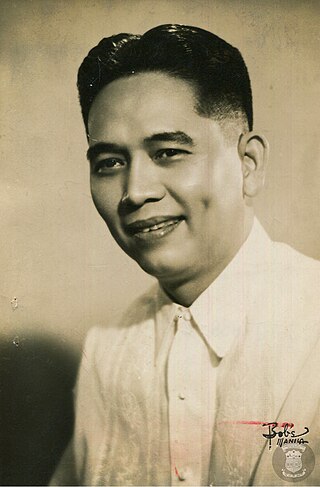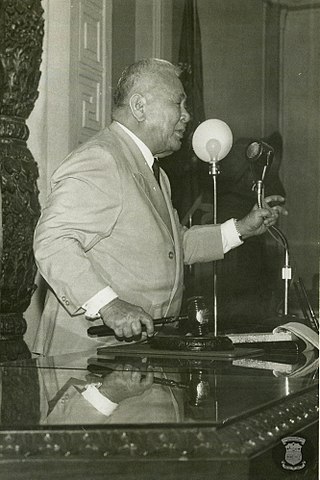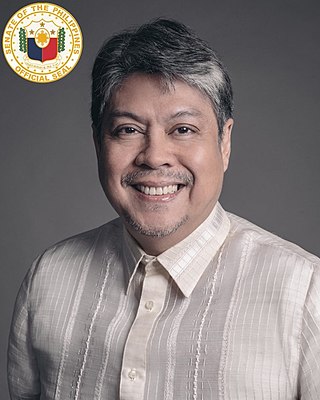
The 2004 election of members to the Senate of the Philippines was the 28th election to the Senate of the Philippines. It was held on Monday, May 10, 2004, to elect 12 of the 24 seats in the Senate. The major coalitions that participated are the Koalisyon ng Katapatan at Karanasan sa Kinabukasan, composed of parties that support the candidacy of President Gloria Macapagal Arroyo, and the Koalisyon ng Nagkakaisang Pilipino, composed of parties that support the candidacy of film actor Fernando Poe Jr. coalition. The Alyansa ng Pag-asa was a minor coalition made up of Aksyon Demokratiko and Partido para sa Demokratikong Reporma–Lapiang Manggagawa. K4 won seven seats, while the KNP won the remaining five contested seats.
The Progressive Party of the Philippines (PPP), also known as the Party for Philippine Progress, was a reformist political party that existed in the late 1950s and the 1960s. It is considered to be the earliest Filipino form of a genuine alternative party to the then-dominant political pair of the Nacionalista Party and the Liberal Party. The party ceased to exist by 1969.

The 2001 election of members to the Senate of the Philippines was the 27th election to the Senate of the Philippines. It was held on Monday, May 14, 2001, to elect 12 of the 24 seats and one mid-term vacancy in the Senate. Independent candidate Noli de Castro, a journalist and former television anchor, was announced as the topnotcher. This became the first synchronized national and local elections held after the ouster of former President Joseph Estrada in January due to a military-backed civilian uprising, popularly known as EDSA II.

The 1998 election of members to the Senate of the Philippines was the 26th election to the Senate of the Philippines. It was held on Monday, May 11, 1998 to elect 12 of the 24 seats in the Senate. The two main competing coalitions in the senatorial election were Lakas—National Union of Christian Democrats—United Muslim Democrats of the Philippines and the Laban ng Makabayang Masang Pilipino umbrella coalition composed of Laban ng Demokratikong Pilipino, Pwersa ng Masang Pilipino, Nationalist People's Coalition, and Partido Demokratiko Pilipino—Lakas ng Bayan. The two coalitions split the 12 contested seats 7–5 in favor of LAMMP.

The 1992 election of members to the Senate of the Philippines was the 24th election to the Senate of the Philippines. It was held on Monday, May 11, 1992. This was the first general election under the 1987 Philippine Constitution. An estimated 80,000 candidates ran for 17,000 posts, from the presidency all the way down to municipal councilors.

A senatorial election was held on November 11, 1969 in the Philippines. While incumbent President Ferdinand Marcos won an unprecedented second full term as President of the Philippines, and his running mate, incumbent Vice President Fernando Lopez was also elected to a third full term as Vice President of the Philippines, their Nacionalista Party-mates also won six of the eight contested seats in the Philippine Senate increasing their majority in the Senate.

A senatorial election was held on November 9, 1965 in the Philippines. The Nacionalista Party wrestled back control of the Senate; originally a Liberal, Senate President Ferdinand Marcos defected to the Nacionalistas, became their presidential candidate and won this year's election.

A senatorial election was held on November 12, 1957 in the Philippines. The Nacionalista Party, despite losing two seats to the Liberal Party still held the Senate with twenty seats. The Liberals who won were actor Rogelio de la Rosa and former basketball player Ambrosio Padilla.

Elections for the members of the Senate were held on November 10, 1953 in the Philippines. Incumbent President Elpidio Quirino of the Liberal Party lost his opportunity to get a second full term as President of the Philippines to former Defense Secretary Ramon Magsaysay of the Nacionalista Party. Quirino's running mate, Senator Jose Yulo lost to Senator Carlos P. Garcia. Vice President Fernando Lopez did not run for re-election and ran for the Senate instead, in which he emerged as the candidate with the most votes. This was the first time that an elected president did not come from the Senate. To further compound the Liberal Party's woes, they also failed to win any seats in the Senate in this election.

Elections for the members of the Senate were held on April 23, 1946, in the Philippines.

A senatorial election was held on November 8, 1971 in the Philippines. The opposition Liberal Party won five seats in the Philippine Senate while three seats were won by the Nacionalista Party, the administration party; this was seen as a consequence of the Plaza Miranda bombing on August 21, 1971, which wounded all of the Liberal Party's candidates and almost took the lives of John Henry Osmeña and Jovito Salonga. Their terms as senators were cut short as a result of the declaration of martial law by President Ferdinand Marcos on September 23, 1972.

A senatorial election was held on November 14, 1967, in the Philippines. The 1967 election for the members of the Philippine Senate were also known as the 1967 midterm election, as the date where the elected candidates take office falls halfway through President Ferdinand Marcos' four-year term. The administration Nacionalista Party won seven seats in the Philippine Senate while the Liberal Party won one seat; the Nacionalistas got the majority in the Senate after having twelve of the 24 seats in the Senate prior to the election.

A senatorial election was held on November 12, 1963 in the Philippines. The 1963 elections were known as a midterm election as the date when the elected officials take office falls halfway through President Diosdado Macapagal's four-year term.

A senatorial election was held on November 10, 1959 in the Philippines. The 1959 elections were known as the 1959 Philippine midterm elections as the date when the elected officials take office falls halfway through President Carlos P. Garcia's four-year term.

A senatorial election in the Philippines was held on November 8, 1955. This was a midterm election, the date when the winners took office falling halfway through President Ramon Magsaysay's four-year term.

A senatorial election was held in the Philippines on November 13, 1951. The election was known as a midterm election as the date when elected candidates take office falls halfway through President Elpidio Quirino's four-year term.

Elections for the Senate of the Philippines were held on November 11, 1947, with eight of the 24 seats in the Senate being contested. These eight seats were elected regularly; the winners were eligible to serve six-year terms from December 30, 1947, until December 30, 1953. Gubernatorial and local elections were held on the same date.

The 2010 election of members to the Senate of the Philippines was the 30th election to the Senate of the Philippines. It was held on Monday, May 10, 2010, to elect 12 of the 24 seats in the Senate. The winners in this election joined the winners of the 2007 election to form the 15th Congress of the Philippines. The senators elected in 2007 will serve until June 30, 2013, while the senators elected in this election will serve up to June 30, 2016. The 2010 presidential election, elections to the House of Representatives as well as local elections occurred on the same date. The Philippines uses plurality-at-large voting for seats in the Senate: the twelve candidates with the highest number of votes wins the twelve seats up for election.

The 2016 election of members to the Senate of the Philippines was the 32nd election of members to the Senate of the Philippines. It was held on Monday, May 9, 2016, The seats of 12 senators elected in 2010 were filled during this election. The winners in this election joined the winners of the 2013 election to form the 17th Congress of the Philippines. The senators elected in 2013 served until June 30, 2019, while the senators elected in this election would serve up to June 30, 2022.

The 2019 election of members to the Senate of the Philippines was the 33rd election of members to the Senate of the Philippines for a six-year term. It was held on May 13, 2019.














